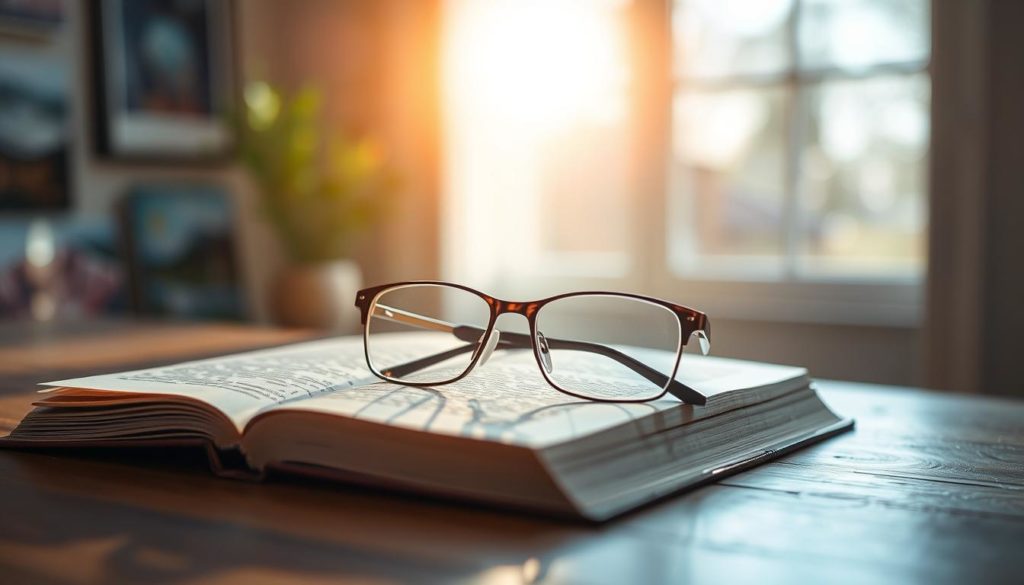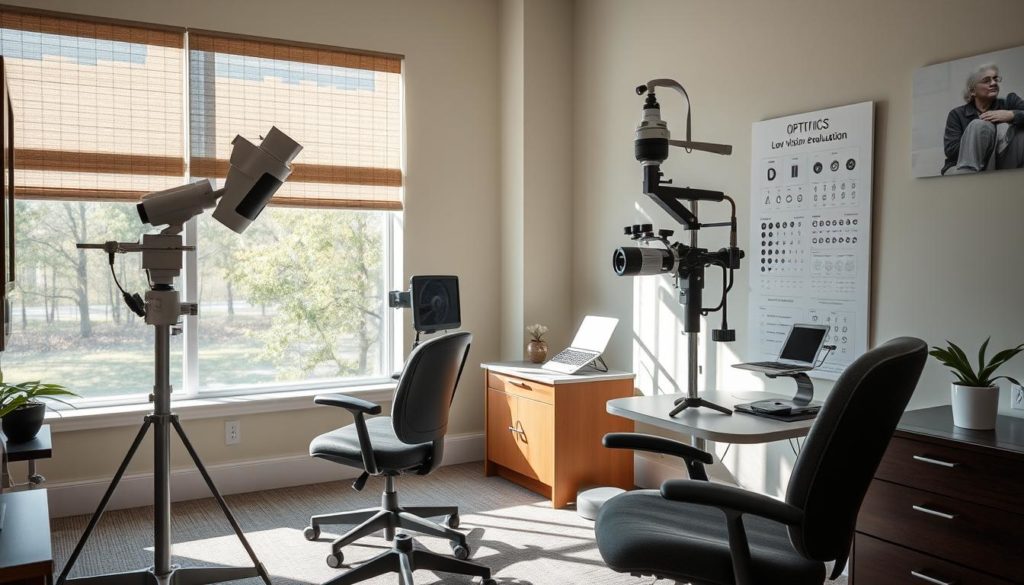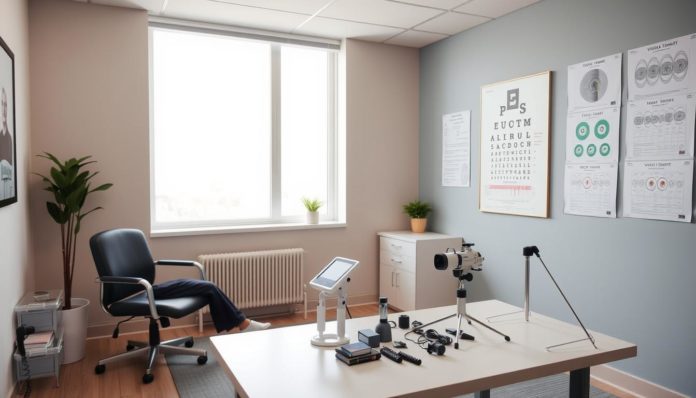Did you know over 4 million Americans have significant visual impairment? This number might double by 2050. That’s why regular, in-depth checks are key. One vital check is a comprehensive low vision exam.
This exam is tailored for those with major vision loss. It employs cutting-edge methods and technology. The goal is to assess the level of vision loss and find the best ways to enhance sight for each person.
Understanding and managing low vision can greatly improve life. Through pinpointing specific issues and making custom plans, these exams boost independence. They also enhance confidence in daily activities.
Understanding Low Vision and Its Impact
Low vision means even with glasses, contacts, or surgery, clarity in sight isn’t achieved. This leads to visual impairment that makes everyday activities tough. Tasks like reading, recognizing people, and moving around become hard. The ongoing sight loss challenges can feel very overwhelming.
It’s key to see how deep impact of low vision goes beyond just not seeing well. It affects a person’s mind and how they connect with others. Many feel they lose their independence and confidence. This makes finding the right help and support crucial.

Dealing with visual impairment means getting thorough check-ups and tailored care plans. Knowing the impact of low vision on a person’s life helps get them the help they need. This support can really improve their life quality.
What to Expect During a Low Vision Exam
A low vision exam is crucial for those with vision impairment. It consists of several steps, each aimed at better understanding your vision issues. Here’s a brief overview:
Initial Consultation and History
The exam starts with a talk where the eye doctor learns about your health and vision history. This chat is key to grasp the full picture of your vision challenges. It paves the way for a care plan just for you.
Visual Acuity Testing
Then comes visual acuity testing. This part checks your ability to see clearly at different distances. These findings help figure out how much your vision is affected. They also aid in finding the right vision aids for you.
Functional Vision Assessment
The last step is the functional vision assessment. It looks at how you manage daily activities with your current sight. Tasks like reading, recognizing faces, and moving around are checked. The results are key to creating a support plan that fits your unique needs.

Key Benefits of Low Vision Evaluation
Low vision evaluations offer many benefits for those with vision loss. A key advantage is finding personalized solutions for each person’s needs. Experts prescribe custom aids like special glasses or magnifiers to improve vision.
Personalized Vision Solutions
Customized visual aids are central in low vision care. They boost daily life by improving tasks like reading and writing. This approach ensures users get the most benefit and comfort.
| Type of Aid | Benefit |
|---|---|
| Specialized Glasses | Improves clarity and focus for close-up tasks |
| Magnifiers | Enlarges text and objects for better visibility |
| Lighting Solutions | Enhances visibility in dimly lit environments |
Improved Quality of Life
Low vision exams greatly enhance quality of life. They make daily tasks easier, boosting independence and confidence. This empowerment leads to a happier, more satisfying life.
In summary, low vision evaluations make a big difference in daily life. They provide tailored aids and solutions for those with vision loss. This directly tackles the specific challenges they face.
Who Should Consider a Low Vision Exam?
A low vision exam is key for those facing sight challenges. Knowing the early signs of low vision symptoms helps. It’s vital to know if you’re eligible for vision impairment testing to manage and improve your vision.
Identifying Symptoms of Vision Loss
Many people miss the first signs of losing sight. Trouble reading small text, being sensitive to bright lights, and having difficulties in dim areas are common. If these sound familiar, a low vision exam might be needed.
Noticing faces can become hard, as can everyday tasks or needing more light. These too suggest you might be losing your sight.
Eligibility for Exam
Who gets tested for vision loss? It’s about whether vision changes affect daily life. If vision problems stop you from doing daily things, consider getting tested. No matter the cause, it’s best to talk to an eye doctor for help.
Role of a Low Vision Optometrist
A low vision optometrist is key in offering specialized eye care to those with serious vision loss. They have deep knowledge in handling conditions that regular eye care can’t fix.
They perform detailed evaluations. These include checking visual sharpness and how well people can see when doing everyday tasks. Their thorough methods make sure they fully understand someone’s vision problems.
Providing the right low vision aids is a crucial part of their work. These aids might be magnifying tools, special glasses, or tech devices. They’re chosen to improve what vision remains.
They also offer advice on changing homes and workplaces to suit visual needs better. This full care approach greatly helps to enhance life quality for those with vision loss.
Working together, the patient and the low vision optometrist ensure care is always getting better. This helps patients see as well as possible and live more independently.
| Primary Tasks | Description |
|---|---|
| Comprehensive Evaluations | In-depth assessments of visual acuity and daily functioning |
| Prescription of Low Vision Aids | Customized devices like magnifiers and specialized lenses |
| Environmental Modifications | Guidance on adapting home and workplace settings |
Vision Rehabilitation Services: What Are They?
Vision rehabilitation services are vital for those with visual impairments. They help restore independence and safety in day-to-day life. We’ll explore the main aspects of these services, like training, assistive technology, and making homes more accessible.
Training and Therapy
Training and therapy are key in vision rehabilitation. They help people adjust to vision loss by teaching new ways to handle daily tasks. These skills range from reading to cooking, easing the shift to a life with visual limitations.
Assistive Technology
Technology has greatly enhanced life for those with vision loss. Assistive devices vary from simple magnifiers to complex software. These tools help with everyday tasks, making life easier for those with vision challenges.
Home Modifications
Adjusting your home is essential in vision rehab. It might mean better lighting, clearing paths, or adding safety rails. These updates make homes safer and more user-friendly, boosting quality of life.
| Service | Description | Benefit |
|---|---|---|
| Adaptive Training | Teaches new techniques to individuals for performing daily tasks. | Enhances independence in everyday activities. |
| Assistive Technology | Includes tools like magnifying glasses and screen readers. | Facilitates easier management of daily tasks. |
| Accessible Home Environment | Involves home modifications to improve safety and functionality. | Creates a safer living space, reducing the risk of accidents. |
Types of Low Vision Aids: Options and Usage
Low vision aids are crucial for people with vision challenges. They make everyday tasks easier. These aids include optical devices, non-optical devices, and electronic aids. Each kind is made to meet different needs, making life better for users.
Optical Devices
Optical devices are widely used as low vision aids. They help people see things up close or far away. For example, magnifiers and telescopes are common. People use handheld magnifiers, stand magnifiers, and telescopes mounted on glasses for different magnification needs.
Non-optical Devices
Non-optical aids help with daily life without changing how we see. They include large-print books and high-contrast items. Using tools like bold-lined paper or large-print calendars makes tasks simpler.
Electronic Aids
Electronic aids use the latest technology to help with vision. They include reading machines and screen readers. With tools like portable video magnifiers, users can adjust magnification and contrast. This makes it easier to read and do other tasks.
- Magnifiers: Available in handheld, stand, and electronic forms.
- Large-print materials: Books, calendars, and documents.
- Reading machines: Devices that scan and read text aloud.
| Type of Aid | Primary Use | Examples |
|---|---|---|
| Optical Devices | Aiding in magnification | Handheld magnifiers, telescopes |
| Non-optical Devices | Improving accessibility | Large-print books, bold-lined paper |
| Electronic Aids | Advanced technological solutions | Reading machines, screen readers |
Finding Low Vision Specialists in the United States
Searching for expert low vision specialists in the United States is critical for managing vision loss. You can get good referrals from your regular eye doctors or GPs. You can also search through reputable groups like the American Academy of Ophthalmology. They keep lists of professionals focused on low vision care.
Getting the right support means looking for specialist eye doctors. These experts are well-trained and offer custom solutions for each person. Talking with them leads to a detailed diagnosis and a plan just for you.
American vision care pros help patients manage their daily lives. They provide services like low vision aids, vision therapy, and using assistive tech.
| Provider | Location | Services Offered |
|---|---|---|
| American Academy of Ophthalmology | Nationwide | Referrals, Resources, Support |
| General Optometrists | Local Practices | Referrals, Initial Consultation |
| Low Vision Clinics | Various Locations | Comprehensive Exams, Vision Therapy, Assistive Devices |
Using resources from eye doctors, GPs, and trusted organizations leads to high-quality care. Finding the right low vision specialists helps patients live confidently.
Accessing Low Vision Resources and Support
Dealing with low vision is easier when you find good support. Many organizations, both big and small, are ready to help. The American Foundation for the Blind (AFB) and the National Federation of the Blind (NFB) have loads of resources. They offer details on help you can get tailored to your needs.
But it’s not just the big organizations that can help. Local groups can be a big support too. Joining these groups lets you meet others who know what you’re going through. It’s a great way to find encouragement, tips, and the latest in helpful technology.
Also, the internet has made finding help easier than ever. Online, you can find websites and social media groups full of people sharing tricks and tips. These online communities also keep you up-to-date on new tech that can help you stay independent and enjoy life more.
FAQ
What is a Low Vision Exam?
A Low Vision Exam is an in-depth eye test for those with serious vision problems. It measures how much vision loss a person has. Experts use special tools and methods for this. They find ways to make the most of what sight remains. This can help people live more independently and improve their quality of life.
Why is understanding low vision important?
Knowing about low vision is key because it impacts everyday tasks. Things like reading, seeing faces, and moving around can be hard. Regular eyewear or surgery can’t fix it completely. Knowing its effects helps people get the right help. This includes therapy and aids for vision, supporting both mental and social well-being.
What should I expect during a Low Vision Exam?
The exam begins with a talk about your health and eyesight history. Then, you’ll have tests to see how well you can see. Lastly, there’s an evaluation of how you handle daily activities. The exam is thorough and designed to meet your specific needs.
What are the benefits of a Low Vision Evaluation?
You get custom solutions like special glasses or magnifiers. These can greatly improve your life. The evaluation makes the most of your vision, helping with daily tasks, confidence, independence, and mental health.
Who should consider a Low Vision Exam?
If reading is hard, lights bother you, or if changes in light are tough, think about this exam. It’s good for anyone whose vision affects daily life, no matter the cause.
What is the role of a Low Vision Optometrist?
This optometrist deals with vision issues that regular eye care can’t fix. They check your eyes thoroughly, suggest aids for vision, and advise on how to adjust your lifestyle. Their goal is to improve your vision and life overall.
What are Vision Rehabilitation Services?
These services offer training and therapy for living with vision loss. They teach how to use helpful tech in everyday life and suggest changes to make your home safer. The aim is to help you be independent and safe.
What types of Low Vision Aids are available?
There are optical aids like magnifiers, non-optical ones like big text, and electronic aids. The electronic aids include reading devices and special software. Each one helps with daily tasks and can be tailored to your needs.
How can I find Low Vision Specialists in the United States?
Look for trusted low vision doctors through recommendations from eye doctors, medical professionals, or groups like the American Academy of Ophthalmology. They offer expert advice on managing low vision and finding ways to cope effectively.
How can I access Low Vision Resources and Support?
Reach out to national and local organizations, support groups, and online resources for vision loss. These offer helpful information, emotional backing, and tips on services and tech. They’re there to help you manage life with low vision better.


